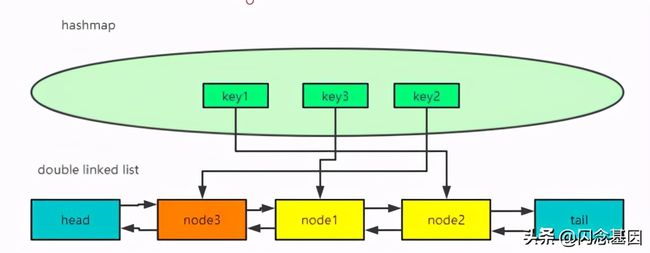java数据结构与算法总结(三十五)--LRU算法原理及其实现
原文链接
LRU是什么
现代计算机,内存仍是相当昂贵的,那么如果利用好、管理好有限的内存,来为用户提供更好的性能,是一个有意义的议题。
LRU(Least Recently Used) 即最近最少使用,属于典型的内存淘汰机制。
通俗的说,LRU算法认为,最近被频繁访问的数据会具备更高的留存,淘汰那些不常被访问的数据。
LRU算法实现思路
根据LRU算法的理念,我们需要:
一个参数cap来作为最大容量
一种数据结构来存储数据,并且需要1. 轻易地更新最新的访问的数据。2. 轻易地找出最近最少被使用的数据,当到达cap时,清理掉。
在这里,我们用到的数据结构是:hashmap+双向链表。
1.利用hashmap的get、put方法O(1)的时间复杂度,快速取、存数据。
2.利用doublelinkedlist的特征(可以访问到某个节点之前和之后的节点),实现O(1)的新增和删除数据。
如下图所示:
当key2再次被使用时,它所对应的node3被更新到链表头部。
假设cap=3,当key4创建、被访问后,处于链表尾部的node2将被淘汰,key1将被清楚。
LRU的简单实现
节点node,存放key、val值、前节点、后节点
class Node{
public int key;
public int val;
public Node next;
public Node previous;
public Node() {
}
public Node(int key, int val) {
this.key = key;
this.val = val;
}
}双向链表,属性有size、头节点、尾节点。
提供api:
- addFirst(): 头插法入链表
- remove(): 删除最后一个节点
- remove(Node node):删除特定节点
- size():获取链表长度
class DoubleList{
private int size;
private Node head;
private Node tail;
public DoubleList() {
this.head = new Node();
this.tail = new Node();
size = 0;
head.next = tail;
tail.previous = head;
}
public void addFirst(Node node){
Node temp = head.next;
head.next = node;
node.previous = head;
node.next = temp;
temp.previous = node;
size++;
}
public void remove(Node node){
if(null==node|| node.previous==null|| node.next==null){
return;
}
node.previous.next = node.next;
node.next.previous = node.previous;
node.next=null;
node.previous=null;
size--;
}
public void remove(){
if(size<=0) return;
Node temp = tail.previous;
temp.previous.next = temp.next;
tail.previous = temp.previous;
temp.next = null;
temp.previous=null;
size--;
}
public int size(){
return size;
}
}
LRU算法实现类
API
- get(int key): 为null返回-1
- put(int key, int value)若map中有,删除原节点,增加新节点若map中没有,map和链表中新增新数据。
public class LRUCache {
Map map;
DoubleList cache;
int cap;
public LRUCache(int cap) {
map = new HashMap<>();
cache = new DoubleList();
this.cap = cap;
}
public int get(int key){
Node node = map.get(key);
return node==null? -1:node.val;
}
public void put(int key, int val){
Node node = new Node(key,val);
if(map.get(key)!=null){
cache.remove(map.get(key));
cache.addFirst(node);
map.put(key,node);
return;
}
map.put(key,node);
cache.addFirst(node);
if(cache.size()>cap){
cache.remove();
}
}
public static void main(String[] args) {
//test, cap = 3
LRUCache lruCache = new LRUCache(3);
lruCache.put(1,1);
lruCache.put(2,2);
lruCache.put(3,3);
//<1,1>来到链表头部
lruCache.put(1,1);
//<4,4>来到链表头部, <2,2>被淘汰。
lruCache.put(4,4);
}
} LRU应用场景
- 底层的内存管理,页面置换算法
- 一般的缓存服务,memcache\redis之类
- 部分业务场景
参考
LRU 策略详解和实现
LRU原理以及应用场景
作者:ZzAllenZz
出处:https://segmentfault.com/a/1190000039256321

